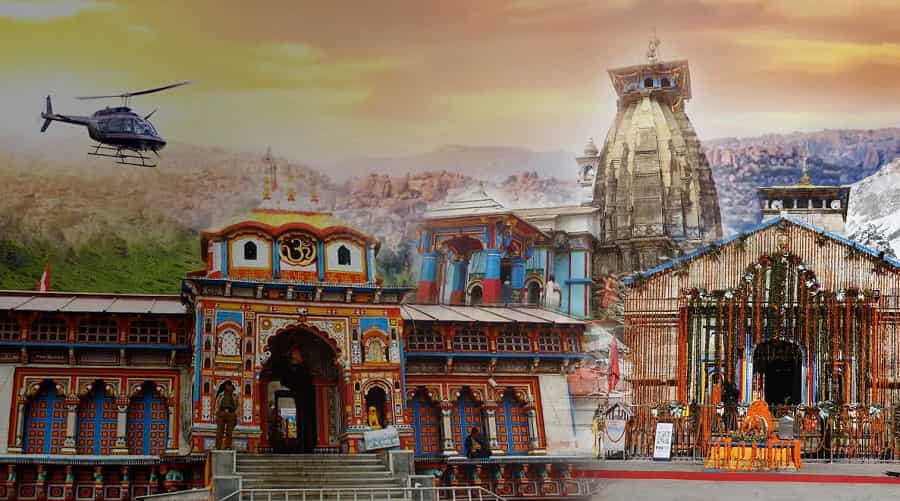Embarking on a helicopter tour to Badrinath and Kedarnath is a unique and exhilarating way to experience two of the most sacred pilgrimage sites in India. Both located in the majestic Himalayas, these temples are not only religious centers but also offer some of the most breathtaking landscapes in the country. However, the timing of your tour is crucial for ensuring a safe, enjoyable, and memorable experience. Here’s an in-depth look at the best times to undertake this journey, taking into account weather conditions, religious events, and personal preferences.

Seasonal Considerations
1. Summer (May to June)
Summer, which spans from May to June, is one of the most favorable times for a helicopter tour of Badrinath and Kedarnath. During these months, the weather in the Himalayas is generally mild and pleasant. Daytime temperatures range from 15°C to 20°C (59°F to 68°F), making it comfortable for both travel and sightseeing.
Advantages:
- Clear Skies: The likelihood of clear skies is high during summer, which is crucial for a helicopter tour. Clear weather ensures that you can fully appreciate the stunning panoramic views of snow-capped peaks, lush valleys, and pristine rivers.
- Accessibility: Both Badrinath and Kedarnath are easily accessible during this period. The heliports are operational, and the risk of flight cancellations due to weather is minimal.
- Comfortable Conditions: With milder temperatures, you can enjoy a more comfortable experience both during the flight and at the temple sites.
Disadvantages:
- Crowds: Summer is peak tourist season, which means that both the helicopter services and the temples can be crowded. If you prefer a quieter experience, you might find this period less ideal.
2. Monsoon (July to September)
The monsoon season, from July to September, is characterized by heavy rainfall, which can significantly impact travel plans in the Himalayan region.
Disadvantages:
- Unpredictable Weather: The monsoon brings frequent showers and fog, which can lead to poor visibility and increased risk of flight cancellations. Helicopter tours might be delayed or canceled due to adverse weather conditions.
- Landslides: Heavy rains can trigger landslides and roadblocks, affecting accessibility and safety. The risk of landslides makes travel to and from the sites more challenging during this season.
- Humidity: The increased humidity can make the journey less comfortable, and the heavy rainfall can also impact the scenic experience.
Advantages:
- Fewer Tourists: If you don’t mind the potential weather disruptions, the monsoon season offers fewer crowds, providing a more serene experience at the temples. Additionally, you might benefit from lower costs for flights and accommodation.
3. Autumn (October to November)
Autumn is another excellent time for a helicopter tour. The weather stabilizes after the monsoon, offering clear skies and crisp temperatures ranging between 10°C to 15°C (50°F to 59°F).
Advantages:
- Stable Weather: The weather conditions during autumn are generally stable and favorable for flying. The clear skies and excellent visibility make it a great time for sightseeing.
- Beautiful Landscapes: The post-monsoon landscapes are lush and vibrant, with clear views of the Himalayan peaks. The crisp air and beautiful fall colors add to the scenic beauty of the journey.
- Festive Atmosphere: Autumn coincides with various local festivals and events, providing a chance to experience the rich cultural and spiritual atmosphere of the region.
Disadvantages:
- Busy Season: While not as crowded as summer, autumn can still be a busy time for pilgrimage travel. Booking in advance is essential to secure your preferred dates.
Religious and Pilgrimage Considerations
1. Char Dham Yatra Season (April to November)
The Char Dham Yatra, which includes Badrinath and Kedarnath, typically runs from late April to early November. During this period, the temples are open to pilgrims, and various religious ceremonies are conducted.
Advantages:
- Active Pilgrimage Sites: Both temples are open and actively hosting pilgrims, offering a vibrant and immersive spiritual experience.
- Religious Events: You may witness various religious ceremonies and festivals that occur during this period, adding to the richness of your visit.
2. Off-Season (July and August)
The off-season, which includes the monsoon months, generally sees fewer tourists. While this can provide a quieter experience, the unpredictable weather can pose challenges.
Advantages:
- Less Crowded: The fewer tourists during the off-season mean you can enjoy a more peaceful experience at the temples and in the helicopter.
- Potential Cost Savings: Travel costs may be lower during this period, including helicopter tours and accommodations.
Additional Tips for Planning Your Helicopter Tour
- 1. Book in Advance: Given the popularity of helicopter tours to these sites, it’s wise to book well in advance, especially if traveling during peak seasons.
- 2. Monitor Weather Conditions: Keep a close eye on the weather forecast leading up to your tour. The Himalayan weather can be unpredictable, and being prepared for sudden changes is crucial.
- 3. Safety Measures: Ensure that your helicopter service provider adheres to all safety regulations and is equipped for Himalayan flying conditions.
- 4. Prepare for Altitude: Both Badrinath and Kedarnath are at high altitudes, so be prepared for potential altitude sickness and take necessary precautions.
- 5. Pack Accordingly: Even if traveling during warmer months, pack warm clothing. The high altitude means temperatures can be much cooler than at the base.
- 6. Respect Local Customs: When visiting these sacred sites, dress modestly and be respectful of local traditions and practices.
Conclusion
Choosing the best time for a Badrinath – Kedarnath helicopter tour depends on your priorities—whether it’s favorable weather, spiritual experiences, or avoiding crowds. Summer and autumn are generally the most favorable times due to stable weather conditions and clear skies. Each season offers a unique experience, so consider your preferences and plan accordingly. By understanding the nuances of each period and preparing in advance, you can ensure a memorable and enriching journey to these sacred Himalayan destinations.
